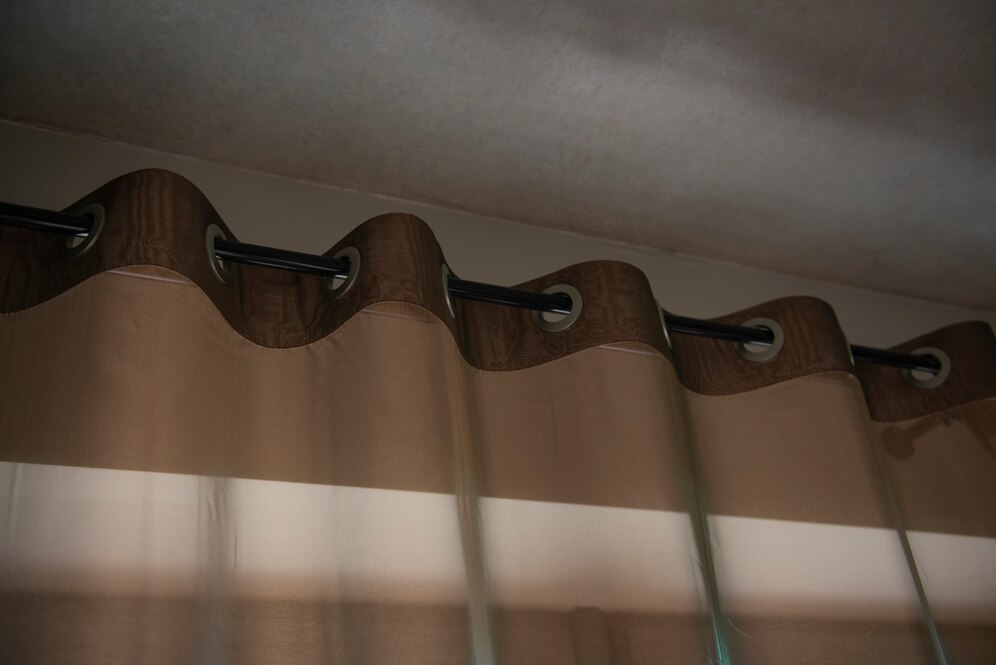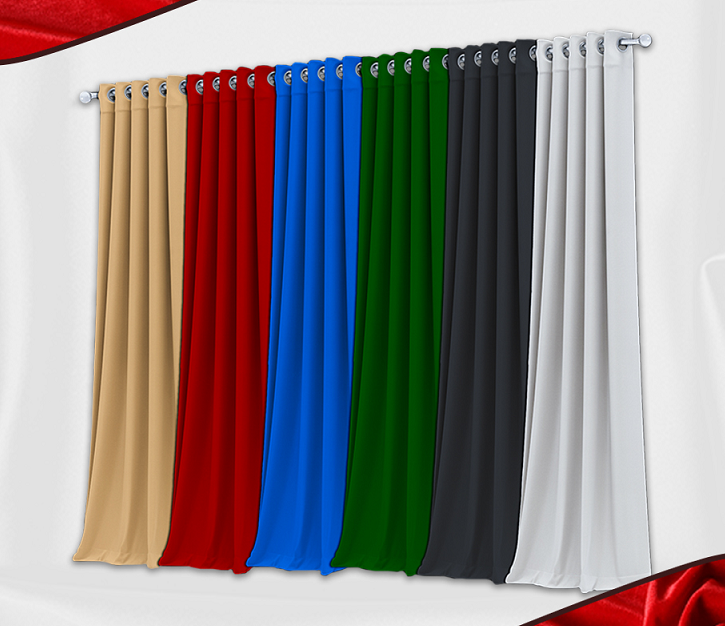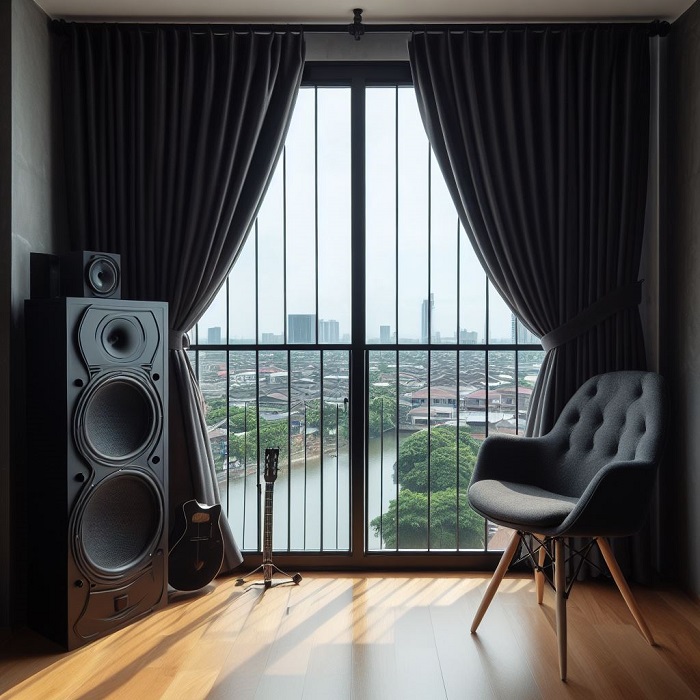What is the Difference Between Acoustic Curtain and Soundproof Curtains: Know from the Experts
Soundproof curtains and acoustic curtains both are intended to lower noise levels in a specified area, although their intended uses and degree of sound attenuation varies.
Typically, acoustic curtains are used to manage sound reflections inside a room or other place. They are constructed of thick, dense materials like fiberglass or mineral wool that absorb sound frequencies. Acoustic curtains can aid in the reduction of echo and reverberation thus enhancing the clarity of voice and the room's overall sound quality.
On the other hand, soundproof curtains are made to stop or lessen the transmission of sound into a room or area. Typically, they are made from several layers of dense, sound-absorbing materials including foam, mass-loaded vinyl, and fiberglass. Soundproof curtains can be used to keep out outside noises like airplanes, traffic, and other obnoxious noises.
While soundproof curtains are made to block or lessen sound transmission from outside a room, acoustic curtains are made to absorb sound inside a space while both types of curtains strive to lower noise levels.
When looking for the best curtains, whether soundproofing or acoustic, you must buy them from a reputable supplier who can ensure the curtains' quality and ability to meet your requirements.
In this post, our experts provide you with a thorough explanation of the differences between soundproofing curtains and acoustic curtains, as well as their uses.
Basic differences between acoustic curtains and soundproof curtains
Sound Attenuation
Soundproof curtains are made to block or diminish the transmission of sound, making them effective at preventing noise from entering or exiting a room. Their Sound Transmission Class (STC) rating, which gauges how well they can dampen airborne sound, is often high.
While echo and reverberation are effectively reduced by acoustic curtains because they are made to absorb sound within a room. Their Noise Reduction Coefficient (NRC) rating, which gauges how well they can absorb sound, is typically high.
Difference in fabric
Fiberglass, mass-loaded vinyl, and foam are common examples of dense, sound-absorbing materials used in soundproof drapes. These materials are made to prevent sound waves from passing through and have a high density. To further muffle sound, they might additionally have a barrier layer made of mass-loaded vinyl or other solid materials.
On the other hand, acoustic curtains are made from softer, more porous materials, like wool, cotton, or polyester, that efficiently absorb sound waves. These less dense materials have fibers that are intended to capture and absorb sound. Sound proof curtains comes in different materials and colours like sound deadening cotton velvet backdrops curtains, sound deading rod pocket curtains etc.
Layers
Multiple layers of materials are frequently used in soundproof curtains to increase their capacity to muffle sound. They might have an outer layer of decorative fabric, one or more layers of materials that absorb sound, and then a layer of mass-loaded vinyl that muffles sound.
Acoustic curtains may have more layers than soundproof curtains, but since their main purpose is to absorb sound waves, the layers may not be as dense. They might have a sound-absorbing layer made of fiberglass or foam that is covered in a lovely fabric.
Appearance
Given that they are intended to suppress sound, soundproof curtains are mostly heavier, thicker, and have a more industrial appearance. They are mostly utilized in commercial or industrial environments and may only be available in a small selection of colors and designs.
Acoustic curtains, on the other hand, may be more aesthetically pleasing and attractive because they are made to enhance the appearance of the room and a good sound quality. They are generally used in music studios, auditoriums, and other locations where sound quality and aesthetics are important. They may come in a wide range of colors and patterns.
Application
Soundproof curtains are often used to exclude outside noises like construction, aircraft, and traffic from entering a room. They can also be used to control noise in a space, like a recording studio or home theater.
In music studios, auditoriums, theaters, and other settings where sound quality and reverberation control are crucial, acoustic curtains are mostly used. They can be used to absorb sound, lessen echo, and reverberation, which enhances speech clarity and sound quality overall.
Cost
Due to their more complicated design and materials, soundproof curtains might be more expensive than acoustic curtains. However, based on the particular type of material used and its size, the cost may vary. Sound quality can be improved in an area more affordably and conveniently by using acoustic curtains.
While both kinds of curtains reduce noise levels similarly, they are more suited to various types of areas and noise issues due to differences in their designs, materials, and applications.
Where are they both used?
Depending on their unique characteristics and uses, soundproof curtains and acoustic curtains are used in various situations and applications. Here are some instances of possible applications for each kind of curtain:
Typically, soundproof curtains are used in:
Homes: To lower noise levels from outside sources like traffic, construction, or neighbors, soundproof curtains can be used in bedrooms, home theaters, or other parts of the house.
Commercial buildings: To lessen noise levels from HVAC systems, lifts, or surrounding businesses, soundproof drapes can be used in offices, conference rooms, or other commercial spaces.
Industrial buildings: Soundproof curtains can be used to block out noise from machinery and equipment in factories or industrial plants.
Acoustic drapes are frequently employed in:
Music studios: Acoustic curtains can be used to absorb sound, reduce reverberation, and improve sound quality in recording studios, rehearsal halls, or home studios.
Auditoriums and theaters: Acoustic curtains can be used to enhance sound quality, lessen echo, and reverberate, making speech or music more understandable in theaters, concert halls, or auditoriums.
Conference rooms: Acoustic curtains can be used to enhance speech clarity and lessen echo in conference rooms or other gathering places, enhancing communication during meetings and presentations.
Restaurants and cafés: To lower noise levels and enhance the overall ambience of the room, acoustic drapes can be used in restaurants and cafes.
The specific type of curtain used will depend on the nature of the noise problem and the objective to be met, but both types of curtains can be used in any room where noise reduction or sound quality improvement is required.
Summing up
In order to reduce noise or absorb sound waves, look for curtains made of high-quality materials like mass-loaded vinyl or fiberglass. To make sure the curtains will work well in your particular use, examine their noise reduction ratings and other parameters. To achieve a proper fit for your room, take into account the size and style of the curtains as well.
To purchase good quality curtains, you should purchase them from a reliable curtain retailer. We, at Saaria, offer premium quality curtains and drapes for a variety of uses like in theaters, schools, churches, music studios, and more at significantly reasonable prices. You’ll get hundreds of samples to choose from. To ensure that you receive the piece you've been looking for, we also offer on-demand customization services.
Browse our vast collections of curtains in different price ranges suiting your requirements and budget. Start shopping now at Saaria for the best quality curtains!















.webp)